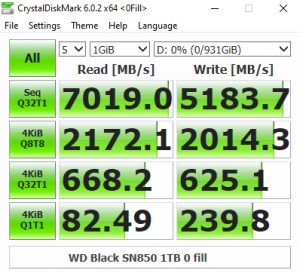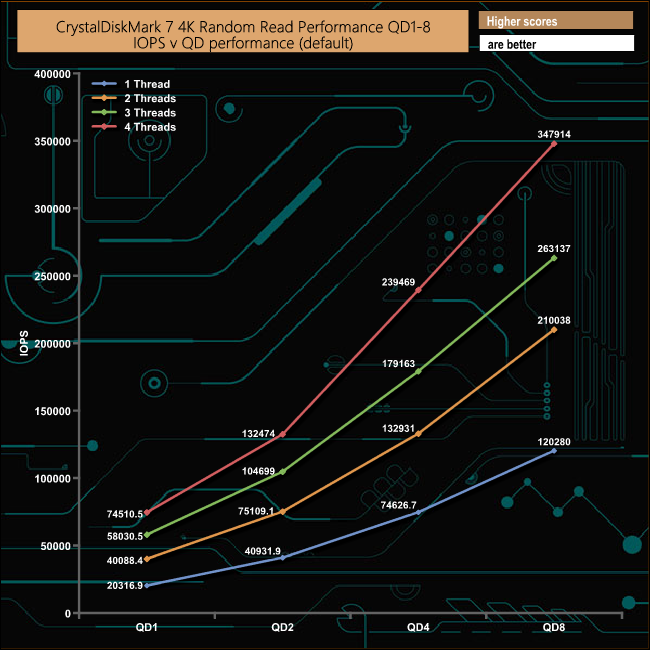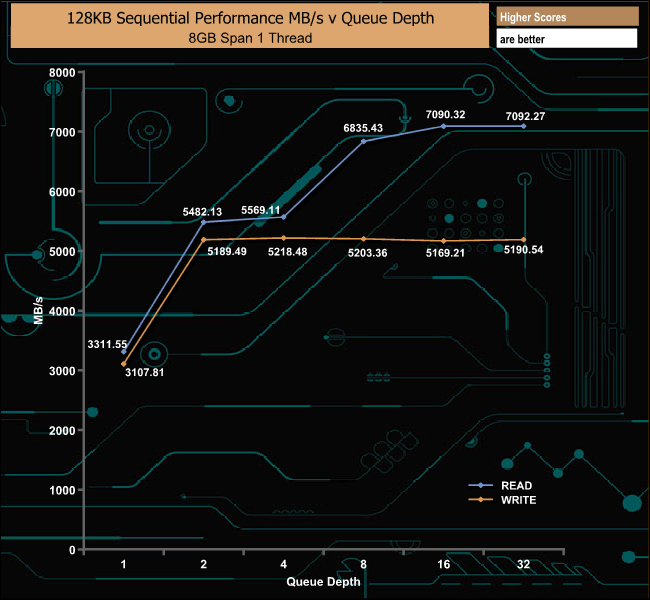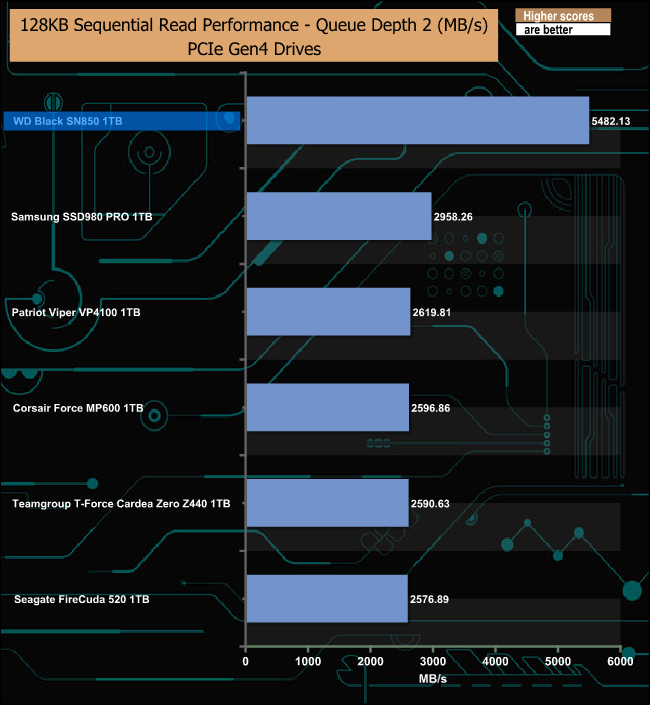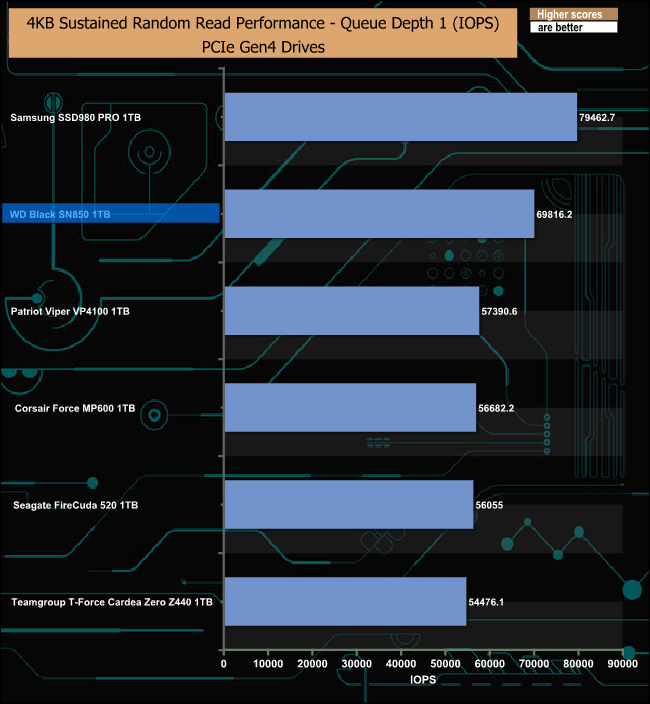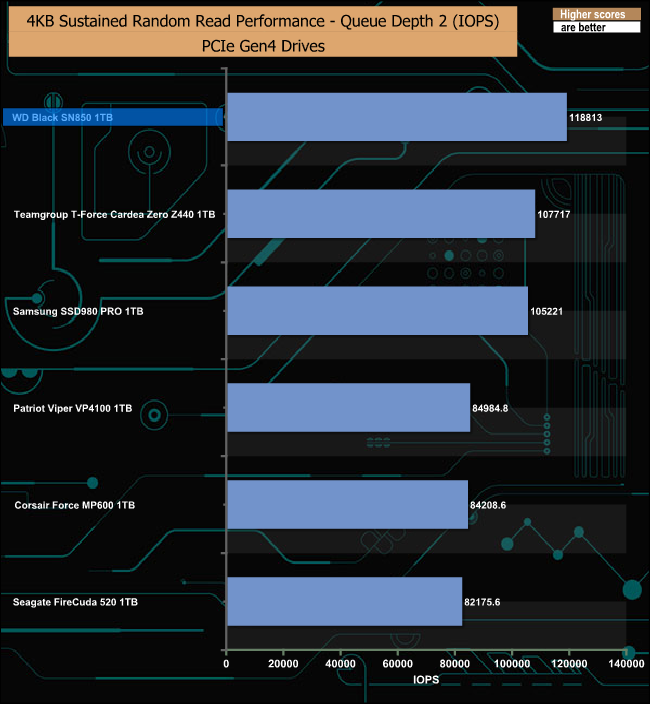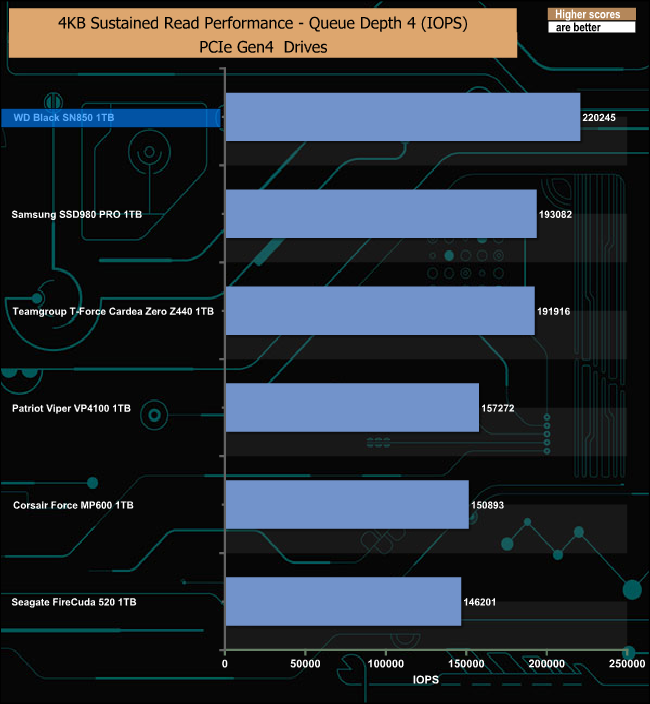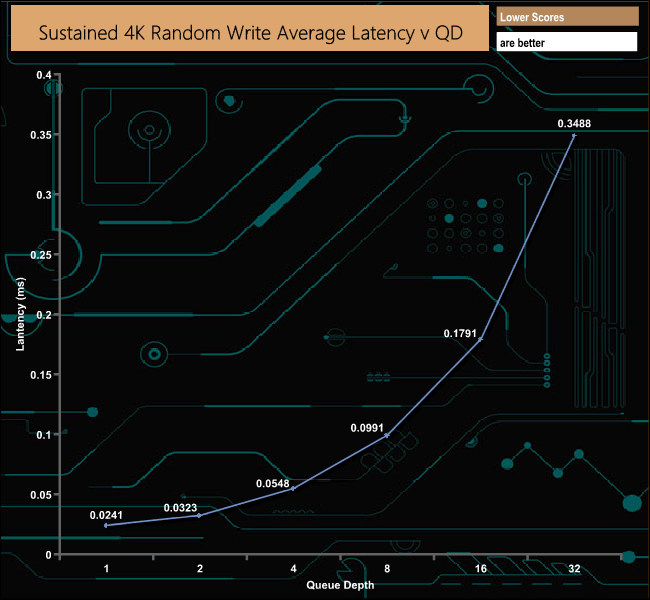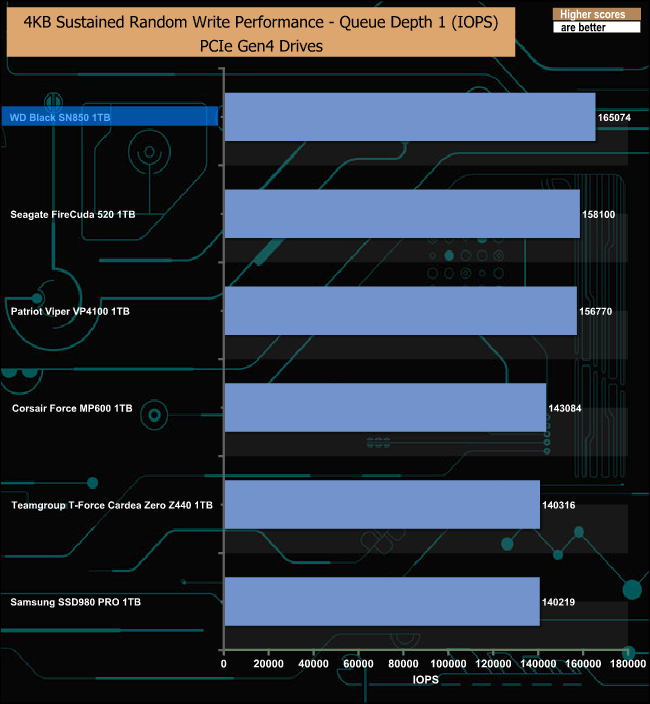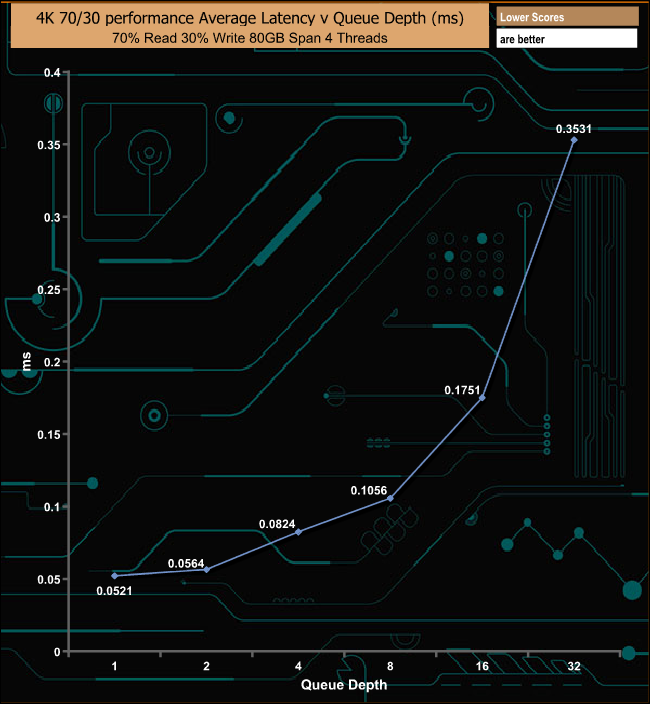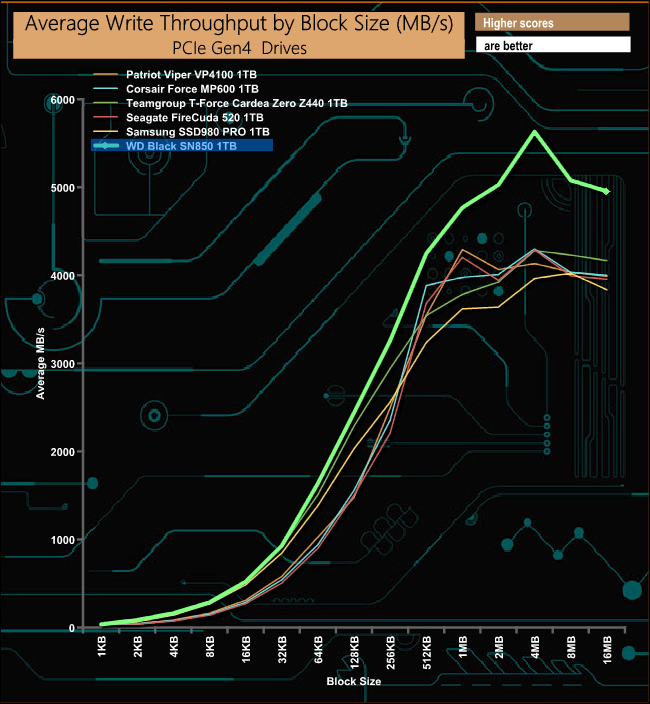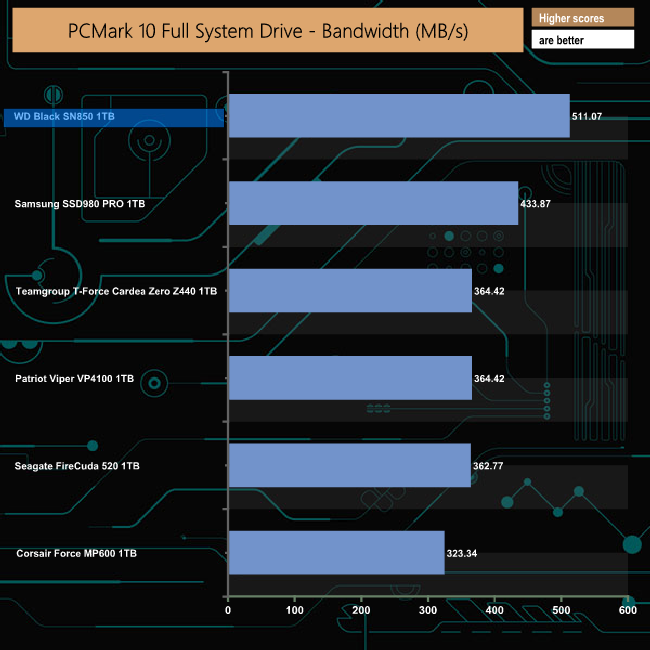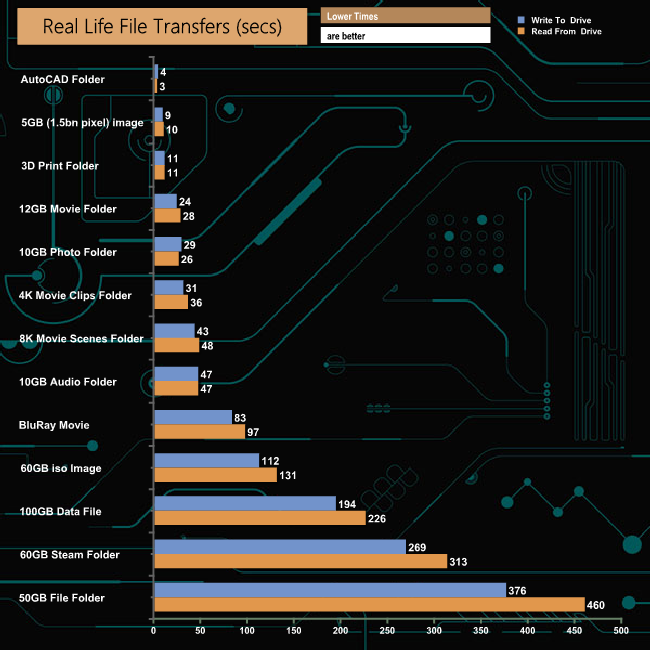
The latest addition to WD's ever-growing range of Black performance and gaming products is the SN850 NVMe M.2 SSD. The new drive is the company's first foray into the PCIe Gen 4 market segment. We check out the 1TB model, priced at £210 here in the UK.
TIMESTAMPS
00:00 Start
00:13 A Gift for me ?
00:28 A letter from Simon Crisp (KitGuru SSD editor)
01:18 Hardware recap
02:23 The SN850 Gen 4 Black
03:34 January’s possible update (with heatsink)
03:50 More details / AMD platform / reviewers guide
04:59 Testing and results
06:43 Simons results and closing thoughts
WD's new drive comes in three capacities at the time of writing – 500GB, 1TB and a 2TB flagship model. The drive uses a combination of an in-house WD G2 controller and 96-layer BiCS4 3D NAND. The SN850 was launched as a standard M.2 2280 drive, but coming along at a later date will be a version with an RGB-equipped heatsink, in a similar vein to the previous SN750, although that one didn't have fancy lights in it.
Sequential read performance for all three drives is quoted as up to 7,000MB/s while Sequential writes vary with capacities. The 500GB drive is rated as up to 4,100MB/s, the 1TB drive 5,300MB/s (the fastest write speed in the range) and the 2TB model 5,100MB/s.
Random read performance is quoted as up to 800,000 IOPS for the 500GB with the 1TB and 2TB drives are rated up to 1,000,000 IOPS, yep that's a million IOPS. As for random writes, the 500GB drive is rated up to 570,000 IOPS, the 1TB drive 720,000 IOPS with the 2TB drive a little slower at up to 710,000 IOPS.
Endurance for the 1TB drive we are reviewing here is quoted as up to 600TBW. Incidentally, the 500GB drive is rated as 300TBW and the 2TB drive 1,200TBW. WD back the SN850 with a 5-year warranty.
Physical Specifications:
- Usable Capacities: 1TB.
- NAND Components: WD 96-layer BiCS4 3D NAND.
- NAND Controller: WD Black G2.
- Cache: 1GB DDR4 DRAM.
- Interface: PCIe 4.0, NVMe
- Form Factor: M.2 2280.
- Dimensions: 22.15 x 80.15 x 2.38mm.
- Drive Weight: 7.5g.
Firmware Version: 611100WD.
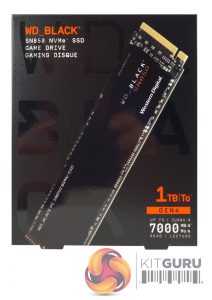
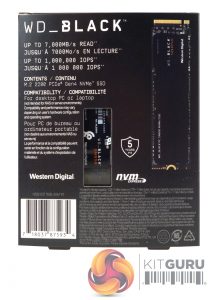
The drive arrives in a smallish box with a clear image of the drive on the front. WD is obviously keen to let you know that this is a fast drive, too, as the 7,000MB/s Sequential read figure is displayed in the bottom right corner of the box. Above this WD highlights the interface the drive uses and its capacity.
The rear of the box has a small clear plastic panel through which part of the drive is visible, sitting in its protective plastic enclosure. To the right of this panel is another image of the drive while to the left of it is that Sequential read figure again, along with the maximum random read IOPS figure. All this information is displayed in English and French. Also on the back of the box is an icon displaying the fact it is supported with a 5-year warranty.

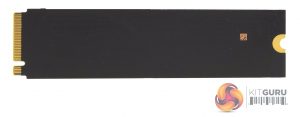
The SN850 is built on a single-sided M.2 2280 format. Under the near full-length product sticker sits the WD Black G2 8-channel Gen 4 PCIe 4.0 controller, two packages of 96-layer BiCS4 3D TLC NAND and a 1GB DDR4 cache chip.
WD's SSD management utility goes by the name of Dashboard. Dashboard is pretty comprehensive and allows you to monitor drive status, performance, perform secure erases (currently only by making a bootable USB device), update firmware and monitor temperatures. It also includes a gaming mode which if enabled reduces latency by disabling the low power modes via the firmware.
There’s no cloning tool integrated into the utility but you can download Acronis True Image WD Edition from the WD website.
For testing, the drives are all wiped and reset to factory settings by HDDerase V4. We try to use free or easily available programs and some real-world testing so you can compare our findings against your own system.
This is a good way to measure potential upgrade benefits.
Main system:
AMD Ryzen 5 3600X, 16GB DDR4-2400, Sapphire R9 390 Nitro and an MSI MPG X570 Gaming Edge Wifi motherboard
Other drives
Corsair Force MP600 1TB
Patriot Viper VPN4100 1TB
Samsung SSD980 PRO 1TB
Seagate FireCuda 520 1TB
Teamgroup T-Force Cardea Zero Z440 1TB
Software:
Atto Disk Benchmark 4.
CrystalMark v6.0 & 7.0.0.
AS SSD 2.0.
IOMeter.
Futuremark PC Mark 10.
All our results were achieved by running each test five times with every configuration this ensures that any glitches are removed from the results. Trim is confirmed as running by typing fsutil behavior query disabledeletenotify into the command line. A response of disabledeletenotify =0 confirms TRIM is active.
CrystalDiskMark is a useful benchmark to measure theoretical performance levels of hard drives and SSDs. We are using v7.0.
In the CrystalDiskMark v6.0.2 4K QD32 test the WD Black SN850 sits in second place behind Patriot's VP4100 drive. Using this benchmark we could confirm the official 7,000MB/s Sequential read figure with a test result of 7,022MB/s. However, the write result of 5,188MB/s is a little short of the official 5,300MB/s.
Comparing the two result screens it appears that the WD Black G2 controller doesn't have a preference when it comes to the type of data it's being asked to handle.
The latest version of CrystalDiskMark, version 7, includes a couple of profiles that can be used for testing – Peak Performance and Real World. The result screens for these two profiles not only display MB/s results but also IOPS and latency.
Looking at the results for Sequential read/write performance we could confirm both official Sequential performance figures. The drive is rated up to 7,000MB/s for reads, with the tested drive producing 7,071MB/s and up to 5,300MB/s for writes, with the best test result of 5,324MB/s.
When it comes to random performance the drive is rated as up to 1,000,000 IOPS for reads and up to 720,000 IOPS for writes but as you can see from the Peak Performance results, the best we saw from the drive in the CDM 7 benchmark was 233,898 IOPS for reads and 324,958 IOPS for writes.
We also used CrystalDiskMark 7 to test the random performance of the drive at lower queue depths (QD1 – QD8) where most of the everyday workloads occur) using 1 to 4 threads. The WD Black SN850's read performance climbs smoothly throughout the tested queue depths and threads with a peak performance figure of 347,914 IOPS (1,425MB/s) at QD8.
In the write tests, the best performance came from the three threaded test run which reached 368,492 IOPS (1,509MB/s) at QD8.
The ATTO Disk Benchmark performance measurement tool is compatible with Microsoft Windows. Measure your storage systems performance with various transfer sizes and test lengths for reads and writes. Several options are available to customize your performance measurement including queue depth, overlapped I/O and even a comparison mode with the option to run continuously.
Use ATTO Disk Benchmark to test any manufacturers RAID controllers, storage controllers, host adapters, hard drives and SSD drives and notice that ATTO products will consistently provide the highest level of performance to your storage.
The 1TB Black SN850 is rated as up to 7,000MB/s for Sequential reads and up to 5,300MB/s for writes. Although we couldn't hit those maximums with the ATTO benchmark, the test results of 6,510MB/s for reads and 4,840MB/s for writes are the fastest we have seen to date for a PCIe Gen 4 drive.
AS SSD is a great free tool designed just for benching Solid State Drives. It performs an array of sequential read and write tests, as well as random read and write tests with sequential access times over a portion of the drive. AS SSD includes a sub suite of benchmarks with various file pattern algorithms but this is difficult in trying to judge accurate performance figures.
Although the WD Black SN850's read score of 2682 is only good enough for second spot behind Samsung's SSD980 PRO drive, its write score of 2959 is the fastest we have seen to date for a Gen 4 drive.
IOMeter is another open-source synthetic benchmarking tool which is able to simulate the various loads placed on the hard drive and solid-state drive technology. There are many ways to measure the IOPS performance of a Solid State Drive, so our results will sometimes differ from the manufacturer’s quoted ratings. We do test all drives in exactly the same way, so the results are directly comparable.
We test 128KB Sequential read and write and random read and write 4k tests. The test setup’s for the tests are listed below. Each is run five times.
128KB Sequential Read / Write.
Transfer Request Size: 128KB Span: 8GB Thread(s): 1, Outstanding I/O: 1-32 Test Run: 20 minutes per test
4K Sustained Random Read / Write.
Transfer Request Size: 4KB Span: 80GB Thread(s): 4, Outstanding I/O: 1-32 Test Run: 20 minutes per test
4K Random 70/30 mix Read/Write.
Transfer Request Size: 4KB Span: 80GB Reads: 70% Writes: 30% Thread(s): 4 Outstanding I/O: 2 – 32 Test Run: 20 minutes
WD rate the Sequential performance of the 1TB Black SN850 as up to 7,000MB/s for reads and up to 5,300MB/s for writes. With our own Sequential tests, we could confirm the maximum read figure with a test result of 7092.27MB/s. When it comes to write performance, the best-tested write result of 5,190.54MB/s is a little shy of the official maximum. However, from QD2 to QD32 the write performance is pretty consistent.
128KB Sequential Read Performance v QD Comparison.
The Black SN850 leads the way by some margin in the lower QD tests but at a QD32 the drive loses out to Samsung's SSD980 PRO.
128KB Sequential Write Performance v QD Comparison.
At QD's 1 and 2, the Black SN850 bosses the opposition but then drops behind the Samsung SSD980 PRO for the remaining test runs.
The official 4K random read figure for the 1TB SN850 is up to 1,000,000 IOPS. With our test platform and four-threaded testing, the drive got nowhere near that official maximum figure, the best we saw was 430,473 IOPS. We did a quick test using 16 threads at a queue depth of 32 and saw the performance rise to 742,492 IOPS, still well short of the official maximum.
4K Random Read v QD Performance Comparison
At a QD of 1, the WD Black SN850 trails the Samsung SSD980 PRO but after that, the WD drive rules the roost of all the tested queue depths.
As with the random read testing, our test results fall way short of the official rating of 720,000 IOPS for random writes. The best write figure we saw with our 4-threaded testing was 366,870 IOPS (QD32). Once again we did a quick test using 16 threads at a QD of 32 which produced a performance figure of 611,422 IOPS.
4K Random Write v QD Performance Comparison.
The Black SN850 leads the way at QD1 but quickly falls behind the Samsung SSD980 PRO before regaining the top spot at QD32.
The WD Black SN850 performs very well in our 70/30 read/write mixed test reaching a peak of 365,810 IOPS (1,498MB/s) at QD16 before slipping back to finish the test run at 362,472 IOPS (1,484MB/s).

In our read throughput test, the drive peaks at the 8MB block mark at 5,550.23MB/s before dropping back to finish the test run at 5,499MB/s.
Despite falling short of the official maximum of 7,000MB/s, the WD Black SN850 has the fastest read speed in our throughput test by quite some margin.
In our write throughput test, the drive peaks at the 4MB block mark at 5,631.74MB/s, which is some 331MB/s faster than the official rating of 5,300MB/s.
As with our read throughput test, the write throughput performance puts the WD Black SN850 at the top of the pile by an even bigger margin than the read performance.
The PCMark 10 Full System Drive Benchmark uses a wide-ranging set of real-world traces from popular applications and common tasks to fully test the performance of the fastest modern drives. The benchmark is designed to measure the performance of fast system drives using the SATA bus at the low end and devices connected via PCI Express at the high end.
The goal of the benchmark is to show meaningful real-world performance differences between fast storage technologies such as SATA, NVMe, and Intel’s Optane. The Full System Drive Benchmark uses 23 traces, running 3 passes with each trace. It typically takes an hour to run.
Traces used:
Booting Windows 10.
Adobe Acrobat – starting the application until usable.
Adobe Illustrator – starting the application until usable Adobe Premiere Pro – starting the application until usable.
Adobe Photoshop – starting the application until usable.
Battlefield V – starting the game until the main menu.
Call of Duty Black Ops 4 – starting the game until the main menu.
Overwatch – starting the game until main menu.
Using Adobe After Effects.
Using Microsoft Excel.
Using Adobe Illustrator.
Using Adobe InDesign.
Using Microsoft PowerPoint.
Using Adobe Photoshop (heavy use).
Using Adobe Photoshop (light use).
cp1 Copying 4 ISO image files, 20 GB in total, from a secondary drive to the target drive (write test).
cp2 Making a copy of the ISO files (read-write test).
cp3 Copying the ISO to a secondary drive (read test).
cps1Copying 339 JPEG files, 2.37 GB in total, to the target drive (write test).
cps2 Making a copy of the JPEG files (read-write test).
cps3 Copying the JPEG files to another drive (read test).

The Black SN850 sails through PCMark10's Full System Drive benchmark displaying strong performance in all the test traces.
WD's Black SN850 is the fastest drive we've seen yet overall when tested with PCMark 10's Full System Drive benchmark. In terms of bandwidth, it's 77MB/s faster than the previous fastest drive, Samsung's SSD980 PRO.
For the long term performance stability test, we set the drive up to run a 20-minute 4K random test with a 30% write, 70% read split, at a Queue Depth of 256 over the entire disk. The 1TB SN850 averaged 91,418 IOPS for the test with a performance stability of 58%.
To test the real-life performance of a drive we use a mix of folder/file types and by using the FastCopy utility (which gives a time as well as MB/s result) we record the performance of drive reading from & writing to a 256GB Samsung SSD850 PRO.
We use the following folder/file types:
- 100GB data file.
- 60GB iso image.
- 60GB Steam folder – 29,521 files.
- 50GB File folder – 28,523 files.
- 12GB Movie folder – (15 files – 8 @ .MKV, 4 @ .MOV, 3 @ MP4).
- 10GB Photo folder – (304 files – 171 @ .RAW, 105 @ JPG, 21 @ .CR2, 5 @ .DNG).
- 10GB Audio folder – (1,483 files – 1479 @ MP3, 4 @ .FLAC files).
- 5GB (1.5bn pixel) photo.
- BluRay Movie – 42GB.
- 21GB 8K Movie demos – (11 demos)
- 16GB 4K Raw Movie Clips – (9 MP4V files).
- 4.25GB 3D Printer File Folder – (166 files – 105 @ .STL, 38 @ .FBX, 11 @ .blend, 5 @ .lwo, 4 @ .OBJ, 3@ .3ds).
- 1.5GB AutoCAD File Folder (80 files – 60 @ .DWG and 20 @.DXF).
WD’s Black SN850 displayed a very good consistency of performance for both reads and writes when dealing with the larger file sizes in our file transfer tests. It averaged 518MB/s for writes and 449MB/s for reads in the top six of the larger file transfers.
To get a measure of how much faster PCIe NVMe drives are than standard SATA SSDs we use the same files but transfer to and from a 512GB Toshiba OCZ RD400:
Switching over to the NVMe drive to transfer data to and from the WD Black SN850 saw transfer speeds for the large file transfers rocket and times taken drop dramatically. Eight of the transfers topped well over 2GB/s while two topped 1GB/s.
WD has been hard at work expanding its Black gaming and high-performance range of products. We recently looked at WD's AN1500 add-in-card (review here) which delivered PCIe Gen 4-like speeds but over the PCIe Gen-3 interface. Now, with the Black SN850, we have WD's first crack at a proper PCIe Gen 4 drive.
WD are in the fortunate position to have all three parts of the component jigsaw; NAND, controller and cache chip available in house so all three can be tuned to get the maximum out of any given drive. The SN850 uses WD's G2 controller which is used in combination with BiCS4 96-layer 3D NAND.
WD quote Sequential read/write figures for the 1TB drive as up to 7,000MB/s and up to 5,300MB/s respectively. That 7,000MB/s read figure is the same for all three drives in the range. The entry-level 500GB is rated at 4,100MB/s for Sequential writes, while the 2TB is slightly slower than the 1TB drive at 5,100MB/s. Using the ATTO benchmark we couldn't match those maximums, the tested drive producing a read figure of 6,510MB/s and a write figure of 4,840MB/s.
Even though we couldn't match the official numbers those read and write ATTO results are the fastest we have seen to date for a PCIe Gen 4 drive. Using our own Sequential tests we could indeed confirm that 7,000MB/s rating as the tested drive produced a result of 7092.27MB/s. Again we couldn't quite nail the maximum write figure but got a lot closer at 5,190.54MB/s.
As for random read performance, WD quote an up to 1,000,000 IOPS figure for the 1TB and 2TB drives (the 500GB drive is rated at up to 800,000 IOPS). Random writes are quoted as up to 570,000 IOPS for the 500GB drive, the 2TB drive at up to 710,000 IOPS with the 1TB drive fastest of the three at up to 720.000 IOPS.
We couldn’t get close to these figures with our 4-threaded tests. The best read figure we saw was 430,473 IOPS. We then retested the drive at a QD of 32 and with 16 threads which resulted in a figure of 742,492 IOPS, closer to the official figure but no cigar. Random writes came up short in our tests as well. Our 4-threaded test yielded 366,870 IOPS at a queue depth of 32. Staying at the same queue depth but increasing the thread count to 16 saw the resulting figure rise to 611,422 IOPS.
We may not have got close to the official random results but those QD32 figures for both reads and writes are the fastest we have seen to date from a PCIe Gen 4 drive.
As with all PCIe Gen 4 drives without a heatsink, the WD SN850 can get pretty hot when really pushed so it's wise to make sure it has got some decent cooling.
The drive is also supported by the very good WD SSD Dashboard management software which includes a Gaming Mode. When turned on, the firmware disables the power saving features that are incorporated into the drive allowing lower latencies and more performance. The one annoying aspect of this Gaming Mode is that you have to restart the system to enable/disable it.
We found the 1TB WD Black SN850 available to order on Overclockers UK for £209.99 (inc VAT) HERE
Pros
- Stunning performance.
- WD Dashboard management utility.
- 5-year warranty.
Cons
- Couldn't hit the maximum 4K figures under testing.
KitGuru says: Arriving seemingly from left field, WD's entry into the PCIe Gen 4 market segment, with the Black SN850, has somewhat stolen the show.
 KitGuru KitGuru.net – Tech News | Hardware News | Hardware Reviews | IOS | Mobile | Gaming | Graphics Cards
KitGuru KitGuru.net – Tech News | Hardware News | Hardware Reviews | IOS | Mobile | Gaming | Graphics Cards









